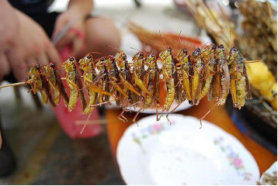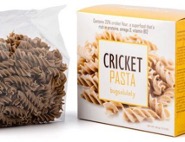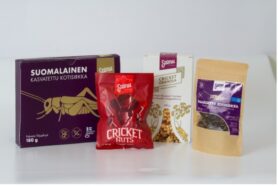Sustainable products
Crickets: from wild to sustainable food resource
By Yihong Li
Our food demand has increased over the years. New sustainable future food source is required to help traditional agriculture to fill the food shortage because the growing temperature of our planet and climate change has caused more natural threats to the crop, resulting in more harm to the crop yield. Thus, how can food production be improved systematically to meet the expanding demand? Recent research gives the answer: crickets. Although many people in the world find it is revolting to eat crickets, these animals have great potential to become one of the most sustainable food alternatives.
The insect diet already exists in the world, and a wide range of its applications origins in Africa and Asia, especially in China, India, and Thailand. This insect diet includes edible moths, crickets, grabs snails and their byproducts, and the crickets are the most consumed insect. A long history in China and Africa of eating crickets has been inherited to these days. For more than two thousand years, fried cricket has been one of Yunnan’s traditional and famous dishes in southern China. According to the ancient Chinese book ‘Li Ji,’ only the emperor possessed the privilege to enjoy the cricket dishes. In addition, Dr. Mark’s investigation in 2015 has shown that edible crickets have been being popular in Europe and America due to their nutritional benefits and food security.

Fried crickets in Yunnan
Why farm the crickets?
As the popularity of cricket as a foodstuff is slowly growing, the demand is growing for producing them as a crop. Sridhar Dharmapuri, the Senior Food Safety and Nutrition Officer in the FAO Regional Office for Asia and the Pacific, has implied: “Crickets are nutritious and their farming is sustainable for the environment. It’s a win-win situation for the consumer and the planet.” Crickets are a potential food resource because they boast abundant nutrients: high protein, lipids, essential amino acids, mineral elements, and energy. The nutritional composition differs from different cricket species. From Dr. Afton’s 2017 research, the house cricket they raise contains 16.5% protein, 8.8% fat, 2.2%Carbohydrates, 5,75 µg/100g Vitamin B, 1.7g/100g Iron, and 2.5g/100 Omega-6 fatty acids. In contrast, beef cattle contains 21.1% protein, 4% fat, 0% Carbohydrates, 1.14 µg/100g Vitamin B, 2.14g/100g Iron, and 0.1g/100 Omega-6 fatty acids. We can see the advantages in microelement and fat from the crickets.
Dr. Afton also suggested that there are only 4.19 (m3/kg produced) in water footprint ratio and 1.7 (kg feed/kg edible mass) feed conversion ratio in crickets production, while in beef cattle, the water footprint and feed conversion ratio are 7.48(m3/kg produced) and 25(kg feed/kg edible mass). Dr. Henlay also stated in 2021 that, compared to livestock farming, rearing crickets as mini livestock results in less emission of green gas, low water and feed intake, and small land requirements. This means, when compared to traditional livestock, like cattle or goats, crickets only need very little feed, water, and space to farm.
Cricket can also be raised on agricultural byproducts or weeds, saving more space and helping clean the environment. In Europe, rearing crickets was introduced ten years ago. The Netherlands, Belgium, France, and Finland all own cricket farms, and some may develop a special and sustainable method: a Finnish company EntoCube raises crickets in a 60-year-old mine. The mine generates free heating-geothermal heat and contains a microbe and pest-free environment; one farm in the Netherland called Dutch Cricketfarm rears the crickets in bins which regulate itself with temperature, humidity and feed, saving space, labor, and reducing the environmental impact. Generally speaking, cricket farm has shown their unique merits in the agriculture industry.
What about the cricket food products?
Once crickets are farmed in adequate quantities and with good nutritional value, the next step is to get them in appealing forms onto people’s plates. You might be wondering how crickets can be made into the food and what do they look like. Besides cooking cricket as the dishes directly, some companies, like Bugsolutely, introduced a new insect food: packaged processed insects (PPIs). PPIs integrate dry insects in pieces or powder (such as cricket flour) and in packaged food such as snacks, pasta, energy bar, or meatball. The cricket powder has been widely used in energy bars, and most of these bars contain 5 to 10% cricket powder. Besides that, the Finnish startup EntoCube also retails edible-insects products such as cricket “nuts,” cricket jar, and cricket granola.

Cricket pasta from Bugsolutely

Edible-insect products from EntoCube
You may ask if there are any risks from consuming crickets? The answer is yes, but it depends on the cricket species, processing methods, and storage conditions, like any other food product. Eating crickets or cricket products are usually safe, but sometimes there are still risks. For instance, the cricket powers contain the shell, and the shell consists of chitin. An enzyme in the human body called chitosan enzyme/ chitotriosidase is the tool to break down chitin. If people who do not have enough of this enzyme eat cricket food, they might be allergic; eating too much cricket feet might result in intestinal discomfort. Moreover, in 2016, Dr. Islamiyat indicated in the study that some crickets can contain cyanogenic glycosides, a naturally poisonous compound consumed by crickets. Eating these crickets may result in acute poisoning, leading to growth retardation and neurological symptoms due to a damaged central nervous system. But this potential toxicity depends on the species and farming methods of crickets.
Are these cricket products affordable? Yes, although a little bit more expensive. Price has been the important focus for people who wish to achieve sustainable and eco-friendly lifestyles. Due to Dr. Juan’s research in 2020, it is unoptimistic to say, compared with other protein-rich food ingredients, the market price of the product cricket powder is much higher. The main reason is that the rearing practice causes much labor costs. The feed price is another cause of the increasing price of the cricket product that the specially formulated feed for cricket is relatively expensive. To make efforts to reduce the market price of cricket products, some western country farms try to conduct a production procedure that could lower the human labor aspect. For example, the company EntoCube has developed an automatic system in their closed breeding bins to provide the cricket feed and water automatically and safely, largely saving labor costs.
To conclude, cricket food can be the future food alternatives, but you can also experience it nowadays. It has great potential in developing our food system and unique selling points in the market. If you wish to help protect the environment through a small and simple start, cricket food will be your smart choice.
Resource:
Bolarinwa, I. F., Oke, M. O., Olaniyan, S. A., & Ajala, A. S. (2016). A review of cyanogenic glycosides in edible plants. Toxicology-New Aspects to This Scientific Conundrum, 179-191.
Bugsolutely website: https://www.bugsolutely.com/
Entocube startup: https://entocube.com/en/
Finke, M. D., Rojo, S., Roos, N., van Huis, A., & Yen, A. L. (2015). The European Food Safety Authority scientific opinion on a risk profile related to production and consumption of insects as food and feed.
Halloran, A., Hanboonsong, Y., Roos, N., & Bruun, S. (2017). Life cycle assessment of cricket farming in north-eastern Thailand. Journal of Cleaner Production, 156, 83-94.
Magara, H. J., Niassy, S., Ayieko, M. A., Mukundamago, M., Egonyu, J. P., Tanga, C. M., … & Ekesi, S. (2021). Edible Crickets (Orthoptera) Around the World: Distribution, Nutritional Value, and Other Benefits—A Review. Frontiers in nutrition, 7, 257.
Reverberi, M. (2020). Edible insects: cricket farming and processing as an emerging market. Journal of Insects as Food and Feed, 6(2), 211-220.
Reverberi, M. (2021). The new packaged food products containing insects as an ingredient. Journal of Insects as Food and Feed, 1-8.
Vogel, G. (2010). For more protein, filet of cricket.

